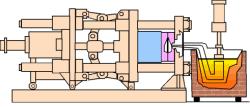Zinc Die Casting is a highly versatile and efficient manufacturing process, offering numerous advantages such as exceptional strength, precision, and design flexibility. However, when it comes to considering Zinc Die Casting for your project, understanding the pricing dynamics is crucial. From material costs to tooling expenses, several factors influence Zinc Die Casting prices. In this article, we delve into the intricacies of Zinc Die Casting pricing, explore key factors affecting costs, examine industry trends, and provide strategies for optimizing expenditure. Understanding Zinc Die Casting Pricing. Navigating Zinc Die Casting Prices: Factors, Trends, and Strategies
Zinc Die Casting prices are influenced by a combination of factors, including:
1. Material Costs. The cost of zinc alloy, the primary material used in the die casting process, significantly impacts pricing. The price of zinc alloy can fluctuate based on market demand, availability, and global economic conditions. Additionally, the alloy composition can affect material costs, with premium alloys commanding higher prices.
2. Tooling Expenses. Tooling costs, including the design and fabrication of molds or dies, represent a substantial initial investment in Zinc Die Casting projects. The complexity of the part geometry, size, and intricacy of details influence tooling expenses. However, once the molds are created, they can be used for high-volume production runs, amortizing the initial investment over time.
3. Production Volume. The quantity of parts being produced directly impacts per-unit costs in Zinc Die Casting. Generally, higher production volumes lead to economies of scale, resulting in lower unit costs. Conversely, smaller production runs may incur higher per-unit costs due to setup and overhead expenses.
4. Surface Finishing and Secondary Operations. Additional processes such as machining, polishing, plating, or powder coating contribute to Zinc Die Casting prices. Surface finishing requirements, including aesthetic considerations and functional enhancements, can add to the overall cost of the project.
5. Design Complexity. The complexity of the part design influences manufacturing complexity and, consequently, pricing. Intricate shapes, thin walls, undercuts, and complex geometries may require specialized tooling or additional processing steps, impacting costs.
In recent years, several trends have influenced Zinc Die Casting prices:
1. Fluctuations in Material Costs. Volatility in zinc prices due to supply chain disruptions, geopolitical factors, and global demand fluctuations can affect overall project costs. Manufacturers must closely monitor market trends and adjust pricing strategies accordingly.
2. Demand for Sustainable Practices. Growing emphasis on sustainability and environmental responsibility has led to increased demand for Eco-friendley manufacturing processes. Zinc Die Casting, known for its recyclability and minimal material waste, aligns well with sustainability goals, potentially influencing pricing dynamics.
3. Technological Advancements. Advancements in die casting technology, such as the use of simulation software for mold design optimization and process efficiency improvements, have the potential to reduce production costs and lead times. However, initial investments in technology upgrades may impact pricing in the short term.
Strategies for Optimizing Zinc Die Casting Expenditure:
To maximize value and minimize costs in Zinc Die Casting projects, consider the following strategies:
1. Design for Manufacturability. Collaborate with experienced engineers and designers to optimize part designs for the die casting process, minimizing complexity and material usage while maximizing efficiency.
2. Consolidate Production Runs. Where feasible, consolidate production runs to leverage economies of scale and reduce per-unit costs.
3. Evaluate Material Alternatives. Explore alternative zinc alloys or material combinations to achieve desired performance characteristics at a competitive price point.
4. Streamline Secondary Operations. Optimize surface finishing and secondary operations to minimize costs while meeting quality requirements.
5. Partner with Experienced Suppliers. Work with reputable Zinc Die Casting suppliers who offer expertise, reliability, and competitive pricing.
Die Casting Zinc Company offers a cost-effective and efficient solution for producing high-quality hardware components with exceptional strength, precision, and design flexibility. By understanding the factors influencing Zinc Die Casting prices, staying informed about industry trends, and implementing strategic cost-saving measures, manufacturers can optimize expenditure while achieving their project objectives. As the manufacturing landscape continues to evolve, proactive management of Zinc Die Casting pricing remains essential for success in today’s competitive marketplace.
Zinc Die Casting Company makes metal parts for several industries. To get metal parts prices or prices for zinc die castings, or Email us at Sales@DieCastingZinc.com for die casting part prices or Zinc Die Casting Tooling Prices.
#California, #DieCastingCompany, #DieCastingTooling, #DieCastingZincCompany, #LosAngeles, #ZincCastings, #ZincDieCasting, #ZincParts


